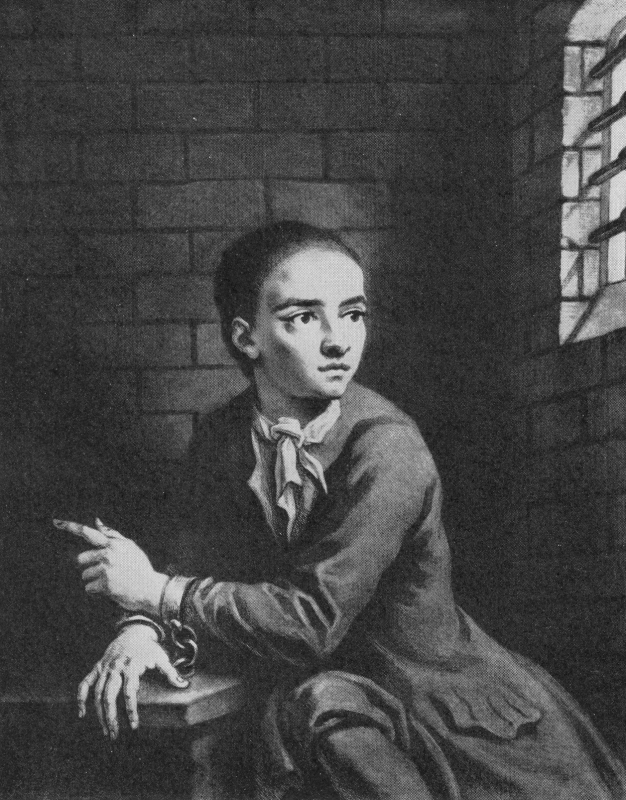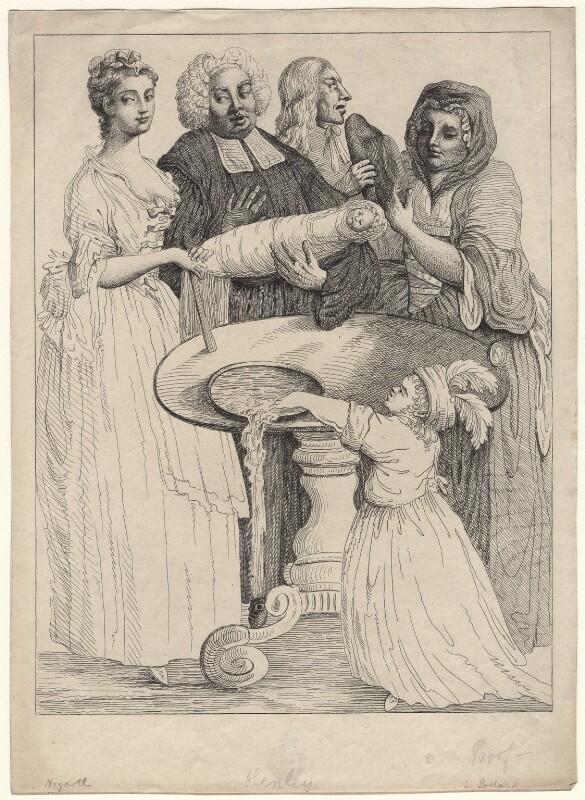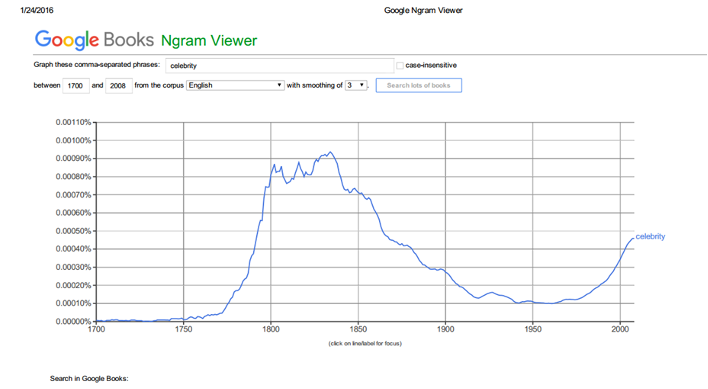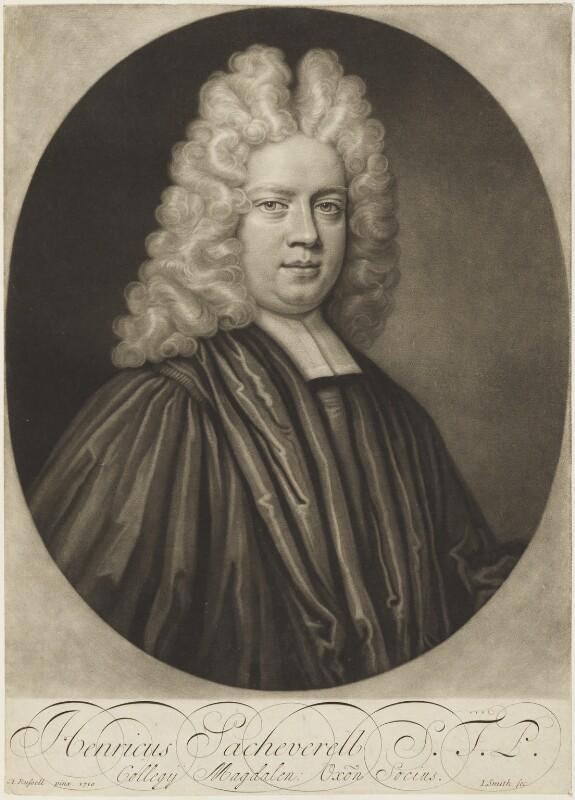Abstract
Celebrity was a form of sociability as well as a form of publicity that took its modern form over the course of the long eighteenth century. It was related to, but distinct from, the experience of fame. A recognizably modern form of celebrity can be identified in Britain by the later seventeenth century. By the turn of the eighteenth century, celebrity was a common form of fame that relied upon print and other media as well as on a modern sense of the self as a distinct, individual character. Eventually, the word ‘celebrity’ began to be used in the early nineteenth century as a noun identifying particularly famous, and interesting, individuals.
Celebrity is a form of fame that became prominent in the modern age. The historiography of celebrity has taken off in the twenty-first century, and many of these works have advanced the claim that celebrity was ‘invented’ in the long eighteenth century, and more particularly in the latter part of the eighteenth and the early nineteenth century.1 Much has been made of the growing popularity of the word ‘celebrity’ itself, which came to be used to refer to the experience of famousness in the later eighteenth century. By the early nineteenth century, one could find references to real people as ‘celebrities’. Stella Tillyard notes that ‘the Oxford English Dictionary finds the first printed use of the word ‘celebrity’ as applied to a person in 1849, and the persistent identification of individuals as ‘celebrities’ only entered everyday culture, in England at any rate, with the explosive growth of the popular press and mass literacy at the end of the nineteenth century’.2
- 1. Antoine Lilti, Figures publiques : l’invention de la célébrité 1750-1850 (Paris : Fayard, 2014); English edition: The Invention of Celebrity, trans. Lynn Jeffress (Cambridge and Malden: Polity Press, 2017); see also Tom Mole, Byron’s Romantic Celebrity: Industrial Culture and the Hermeneutic of Intimacy (Houndmills: Palgrave, 2007).
- 2. Stella Tillyard, ‘Celebrity in Eighteenth-Century London’, History Today (vol. 55, June 2005), p. 20-27, here p. 21.
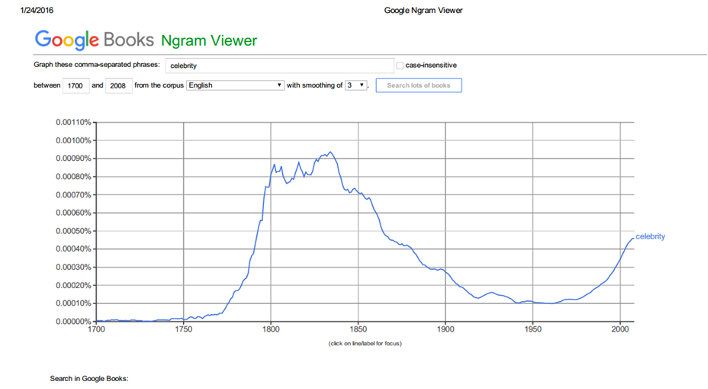
Certainly, the word ‘celebrity’ took on an increased prominence in the latter half of the eighteenth century and the first half of the nineteenth. Google’s Ngram viewer demonstrates the remarkable rise in prominence of the word as found in printed texts during the 1750-1850 period (Fig. 1). Much the same is true of cognate terms relating to celebrity. The word ‘star’ began to refer to ‘a person of brilliant reputation or talents’ in the early nineteenth century. American English began to abbreviate the word ‘fanatic’ to ‘fan’ in the later nineteenth century with reference to baseball team supporters (Mole xi-xii). Before the Victorian age, the word fanatic was a term of derision that referred primarily to Dissenters, although it could occasionally be turned against other scorned groups.3 It took centuries before our contemporary vocabulary of celebrity took shape.
- 3. The Old Whig; Or, The Consistent Protestant, 2 vols. (London, 1739), vol. 2, p. 212-16, turns the language of fanaticism against high church conformists.
The argument for the eighteenth-century invention of celebrity is based on more than just lexical history. Modern celebrity is distinguished from more traditional forms of fame, which are argued to be rooted in premodern senses of honour and glory. Kings, knights and saints achieved fame through their glorious actions and as a result of their exalted social status; they were famous because they accomplished great things, and thus their renown was well earned. Modern celebrity, it is often argued, was a different form of fame. Celebrity was based mainly on having an interesting personality, an interior life that appealed to people who would otherwise not take an interest in a celebrity. Theatre historian Joseph Roach has referred to the modern celebrity as an ‘abnormally interesting’ individual.4 Celebrities had ‘fans’ who did not know them personally, but who seemed to know a lot about them because so much of their life was made public through repeated references to them in print. Celebrities were also well known because their effigies were reproduced in portraits, prints and material artefacts that were sold as commodities. Modern celebrity is thus posited as the product of a modern media ecology in which words and images about people, and especially about exceptionally interesting people, could proliferate.
- 4. Joseph Roach, It (Ann Arbor: University of Michigan Press, 2007), p. 1, 4, 12, and passim.
This distinction between traditional and modern forms of fame, in which celebrity is seen as a distinctly modern form, is not universally accepted. There is an alternative, longer term, history of celebrity that emphasizes continuity between premodern and modern forms of fame.5 This historiography sees celebrity formation as ‘a process (rather than an invention) that has always existed in one form or another in most societies’.6 Like those histories that emphasize the modernity of celebrity, this tradition sees celebrity as a distinct kind of fame – one in which certain individuals are lifted out of obscurity by public interest in their personality as well as their accomplishments or distinguishing characteristics – but it recognizes that ‘celebrities’ existed as a social form well before the modern age. From this perspective, some kings, knights and saints can be understood as celebrities, even those who lived before the eighteenth century.
- 5. Leo Braudy, The Frenzy of Renown: Fame and Its History (New York: Vintage, 1997).
- 6. Brian Cowan, ‘Histories of Celebrity in Post-Revolutionary England’, Historical Social Research/Historische Sozialforschung Supplement (vol. 32, 2019), p. 83-98, here p. 85 ; Robert Van Krieken, Celebrity Society, 2nd ed. (London: Routledge, 2019).
The advantage to this perspective is that it doesn’t commit to positing a precise moment when modern celebrity was invented. Social and cultural changes rarely take place abruptly but are rather produced slowly through a process of accumulation and successive adaptation to newly emergent social forms and cultural mores.7 This allows historians to take into account earlier forms of celebrity formation that began well before the Romantic age and it permits us to acknowledge the points of commonality and connection between pre-modern forms of fame and its modern varieties.
- 7. Norbert Elias, On the Process of Civilization: Sociogenetic and Psychogenetic Investigations, trans. Edmund Jephcott, vol. 3, in the Collected Works of Norbert Elias (Dublin: UCD Press, 2012); Stephen Mennell, Norbert Elias: An Introduction (Dublin: UCD Press, 1992).
All of the putative qualities of the modern celebrity can be identified well before the later eighteenth century. There were plenty of abnormally interesting people who lived before 1750, and they attracted the attention of fans, followers, and writers who chronicled the details of their lives.8 A modern media ecology did not emerge fully formed in the later eighteenth century; print culture in particular has a much longer history that begins in the later fifteenth century.9 Portraiture has an even longer history and has played an important role in cultivating public interest in celebrated individuals.10 The continuities between premodern and early modern forms of fame are important to acknowledge, and doing so allows for a more nuanced and complex history of celebrity.
One clear example of an early modern celebrity is the case of Doctor Henry Sacheverell (1674-1724), a clergyman who achieved great fame in the first two decades of the eighteenth century as a result of his controversial and politically charged preaching.11 Sacheverell’s Tory sermons proved to be so provocative that they prompted the Whig government to impeach him for high crimes and misdemeanours in Parliament in 1710. Sacheverell provides a clear example of the fuzzy boundaries between supposedly premodern renown and modern celebrity. His fame began with his achievements as a preacher and a Tory propagandist but he quickly became a celebrity when his prosecution turned him into a living martyr for the high church cause. The media ecology and the highly partisan political culture of early eighteenth-century England transformed Sacheverell into an object of popular fascination. Tories held him up as a martyr for their cause and they adopted his effigy as a badge of allegiance. His effigy was reproduced in portraits, cheap prints, fans, medals, handkerchiefs and even shop signs. But it was print culture that really transformed Sacheverell into a celebrity.12 His personality was dissected, criticized and celebrated by all sides of the political and religious spectrum: the controversy surrounding his trial and impeachment was so intense that no one could escape knowing about it and everyone was expected to have an opinion about his case. Sacheverell is an example of a person who achieved celebrity long before the Romantic age, and he exemplifies the way in which early modern fame can be understood as both traditional and modern at the same time.
- 8. Karen A. Winstead, The Oxford History of Life Writing, Vol. 1: The Middle Ages (Oxford: Oxford University Press, 2018); Allan Stewart, The Oxford History of Life Writing, Vol. 2: Early Modern (Oxford: Oxford University Press, 2018).
- 9. Elizabeth Eisenstein, The Printing Revolution in Early Modern Europe (Cambridge: Cambridge University Press, 1983).
- 10. Shearer West, Portraiture (Oxford: Oxford University Press, 2004).
- 11. Brian Cowan, ‘Doctor Sacheverell and the Politics of Celebrity in Post-Revolutionary Britain’, in Emrys Jones and Victoria Joule (eds.), Public Interiors: Intimacy and Celebrity in Eighteenth-Century Literary Culture (Houndmills: Palgrave, 2018), p. 111-37; Greg Jenner, Dead Famous: An Unexpected History of Celebrity from Bronze Age to Silver Screen (London: Weidenfield & Nicolson, 2020), p. 65-67.
- 12. Brian Cowan (ed.), The State Trial of Doctor Henry Sacheverell (Oxford and Malden, Mass.: Wiley-Blackwell, 2012).
Sacheverell is only the most telling case of an obvious celebrity who existed well before the later eighteenth century. One could make a case for some of his contemporaries as well, such as his clerical Whig rival, Benjamin Hoadly or his Grub Street nemesis, Daniel Defoe.13 Both of these figures achieved public notoriety through their writings, often indeed in opposition to Sacheverell’s very public high churchmanship. The print saturation of the long eighteenth century was of course more developed later in the century, but it is fruitless to separate the Romantic age from its predecessors.14 By extending our understanding of celebrity to be part of a continuing historical process rather than an abrupt break with the past, we can better understand how so many aspects of premodern fame persisted into the modern age and indeed helped shape our ‘modern’ experience of celebrity.
Much work on eighteenth-century celebrity has focused on recognizably modern figures such as actors and actresses, impresarios or scandalous figures such as controversial sex workers, rakes and highwaymen or other sorts of criminals.15 This scholarship has been very valuable, but it should be complemented by studies of celebrities whose fame would not have been out of place long before the eighteenth century. Royal families retained their place at the heart of old regime Europe, but they were also incorporated into the more modern forms of fame that we associate with celebrity. Monarchy did not fade away in the eighteenth century. Even the French Revolution was replaced with a Napoleonic empire and ultimately a Bourbon Restoration; in Britain, the Georgian monarchs found a new cultural position as celebrities, thus setting the foundation for a media fascination with the royal family that persists to the present day.16 Military leaders such as the Corsican Pasquale Paoli, the American George Washington or the Haitian Toussaint Louverture all found new power through projecting their personalities as charismatic ‘men on horseback’ who could break through old traditions and forge new nations.17 Religion remained an important source of charismatic power in the age of Enlightenment: aside from famous churchmen such as Sacheverell and Hoadly, there were founders of new religious movements such as the Methodist John Wesley or the Unitarian Joseph Priestley. The clergyman John Henley became known as ‘Orator Henley’ due to his popular and theatrical style of preaching.18
Celebrity was an important part of eighteenth-century sociability because it actively connected famous people with their publics. Celebrities were more than just famous people: they were well-known individuals who cultivated a parasocial relationship with their fans.19 This was a process that was enabled by the ‘media revolution’ of the eighteenth century and particularly by the print saturation of the age, but it was not entirely new to the era. Celebrity has a very long history, but the eighteenth century has a central place in that story.
- 13. Brian Cowan, ‘Hoadly the High and Sacheverell the Low: Religious and Political Celebrity in Post-Revolutionary England’, in Bill Bulman and Freddy Dominguez (dirs.), Political and Religious Practice in the Early Modern British World: Essays in Honour of Peter Lake (Manchester: Manchester University Press, c. 2022), p. 158-78; Brian Cowan, ‘Life and Times’, in Alan Downie and Nicolas Seager (dirs.), The Oxford Handbook of Daniel Defoe (Oxford: Oxford University Press, forthcoming, c. 2024).
- 14. The Multigraph Collective, Interacting with Print: Elements of Reading in the Era of Print Saturation (Chicago: University of Chicago Press, 2018).
- 15. Leslie Ritchie, David Garrick and the Mediation of Celebrity (Cambridge: Cambridge University Press, 2019); Felicity Nussbaum, Rival Queens: Actresses, Performance and the Eighteenth-Century Theater (Philadelphia: University of Pennsylvania Press, 2010); Julie Peakman, Amatory Pleasures: Explorations in Eighteenth-Century Sexual Culture (London: Bloomsbury, 2016); Robert Shoemaker, ‘Sympathy for the Criminal: The Criminal Celebrity in Eighteenth-Century London’, Crime, Histoire & Sociétés / Crime, History & Societies (vol. 24, n° 1, 2020), p. 5-28.
- 16. Natalee Garrett, ‘Royalty, Celebrity, and the Press in Georgian Britain, 1770-1820’, Royal Studies Journal (vol. 9, n° 2, 2022), p. 99-115.
- 17. David A. Bell, Men on Horseback: The Power of Charisma in the Age of Revolution (New York: Farar, Straus & Giroux, 2020).
- 18. Henry Abelove, The Evangelist of Desire: John Wesley and the Methodists (Stanford, CA: Stanford University Press, 1990); Robert E. Schofield, The Enlightenment of Joseph Priestley: A Study of His Life and Work from 1733 to 1773 (University Park: Penn State University Press, 1997), and Schofield, The Enlightened Joseph Priestley: A Study of His Life and Work from 1773 to 1804 (University Park: Penn State University Press, 2004); Graham Midgley, The Life of Orator Henley (Oxford: Clarendon Press, 1973).
- 19. Donald Horton and R. Richard Wohl, ‘Mass Communication and Para-Social Interaction’, Psychiatry (vol. 19, n° 3, 1956), p. 215-29.
Share
Further Reading
Cowan, Brian, ‘News, Biography, and Eighteenth-Century Celebrity’, in Keymer, Thomas and Burrow, Colin (eds.), Oxford Handbooks Online (Oxford: Oxford University Press, 7 Sep. 2016). [DOI: 10.1093/oxfordhb/9780199935338.013.132]
Marshall, P. David, Celebrity and Power: Fame in Contemporary Culture, 2nd ed. (1997 reprint; Minneapolis: University of Minnesota Press, 2014).
Nachumi, Nora and Straub, Kristina (eds.), Making Stars: Biography and Celebrity in Eighteenth-Century Britain (Wilmington: University of Delaware Press, 2022).
Pédron, Anaïs and Siviter, Clare (eds.), Celebrity Across the Channel, 1750–1850 (Wilmington: University of Delaware Press, 2021).
